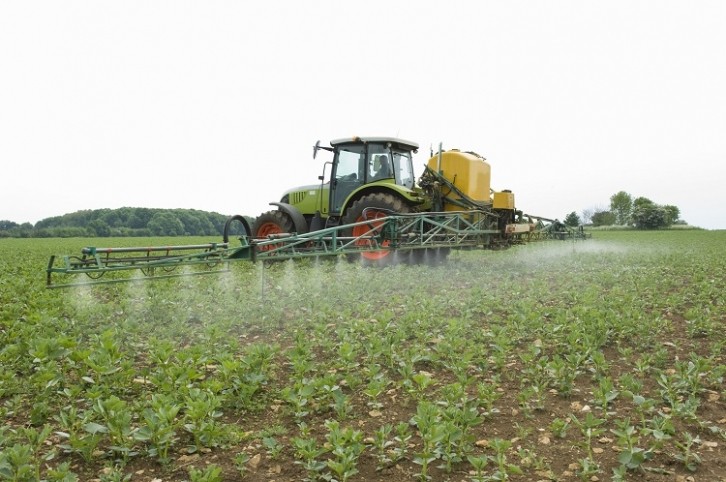Could there be a link between pesticide use and endometrial cancer?

The use of pesticides in agricultural farming has caused concern in recent years, with their direct links to biodiversity loss. They cause further damage to the environment by seeping down through the soil and into the water table.
According to the European Environment Agency (EEA), the use of chemical pesticides in Europe, “remains a major source of pollution, an important driver of biodiversity loss and a possible cause of negative health impacts for exposed users and citizens.” The EEA also believes that pesticide use, “threatens key ecosystem services which help maintain food security in Europe.”
As the understanding of the harm pesticides can do to both the environment and human health grows, so too do the number of scientific research studies on the subject. One such study has investigated if there is a link between pesticide use and endometrial cancer.
What are pesticides?
Pesticides, also known as plant protection products (PPP), are used to control pests, weeds and diseases. Examples include insecticides, fungicides, herbicides, molluscicides, and plant growth regulators. Pesticides can exist in many forms, including solid granules, powders or liquids, and consist of one or more active substances co-formulated with other materials.
Pesticides are used by agricultural farmers to ensure a plentiful supply of food is produced at a reasonable price all year round. Farmers use pesticides to protect crops from insect pests, weeds and fungal disease while they are growing and prevent rats, mice, flies and other insects from contaminating stored foods.
What is endometrial cancer?
Endometrial cancer, also known as womb cancer or corpus uteri cancer, is a type of tumour that develops on the inner lining of the uterus. It is the most common gynaecological cancer in Europe, with a five-year prevalence of 34.7% (445,805 cases). As endometrial cancer is a hormone-dependent cancer, estrogen can play a role in its development and progression.
According to the World Cancer Research Fund International, there is existing evidence to suggest that being overweight or obese, being tall, and consuming a diet with a high glycaemic load, all increase the risk of developing endometrial cancer. But could exposure to chemicals such as pesticides also increase the risk of developing endometrial cancer?
Could pesticides increase the risk of developing endometrial cancer?
A recent study, published in the journal Environmental Health Perspectives, involving the University of Granada (UGR), IDIBELL, the Catalan Institute of Oncology, and the Biohealth Research Institute in Granada (ibs.GRANADA), looked to see if there is a connection between environmental pollutants and endometrial cancer. This collaborative research included contributions from experts at Bellvitge University Hospital and the Biomedical Research Networking Center for Epidemiology and Public Health (CIBERESP).
The study examined if there is a relationship between endometrial cancer and exposure to mixtures of environmental pollutants that can disrupt hormone function. This class of chemicals, also known as endocrine disruptors, act as xenoestrogens and are found in many industrial products, including pesticides, as well as in cosmetics and other everyday consumer products.
Using advanced chemical analysis techniques and biological testing, the researchers assessed the total hormonal burden in the blood of more than 300 women with and without endometrial cancer.
“The use of these biological tests helps us understand the negative impact of chemical mixtures,” explains Marieta Fernández, a UGR professor and researcher at the Biohealth Research Institute in Granada (ibs.GRANADA) and CIBERESP.
The results show a link between exposure to endocrine disruptors and an increased risk of developing endometrial cancer.
“Interestingly, we saw the effect with moderate doses of xenoestrogens, but not with high doses, similar to what was observed with endogenous hormones,” adds Laura Costas, a researcher at IDIBELL and the Catalan Institute of Oncology. “Since this is a hormone-dependent cancer, this relationship is probably linked to the nature of the tumour itself. Therefore, we also want to study whether the presence of xenoestrogens leads to a worse pathological evolution in women who already have the disease.”
The research highlights the negative impact of endocrine disruptors, which exist in some pesticides, on human health and has significant implications for public health.
This research supports the position of the European Environment Agency (EEA), which has stated that, “human exposure to chemical pesticides is linked to chronic illnesses such as cancer, and heart, respiratory and neurological diseases.”
However, it is important to note that under EU and UK regulation, chemicals that are carcinogenic, have endocrine disruption properties or are highly persistent in the environment, are not allowed to be used as pesticides. Though, such pesticides are used in some countries around the world.
Alternatives to chemical pesticides
Discover more about the scientific strides being made in the search for environmentally friendly alternatives to pesticides:
Organic alternative to chemical pesticides discovered
Are red nets an eco-friendly alternative to pesticides?
Source: Total Effective Xenoestrogen Burden in Serum Samples and Risk of Endometrial Cancer in the Spanish Screenwide Case–Control Study
Published online: 28 February 2024
DOI: https://ehp.niehs.nih.gov/doi/10.1289/EHP13202
Authors: Laura Costas, Jon Frias-Gomez, Francisco M. Peinado, Jose Manuel Molina-Molina et al.


























